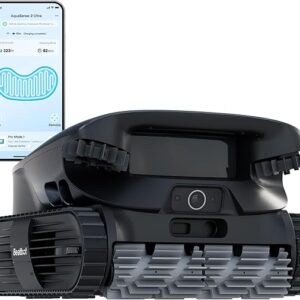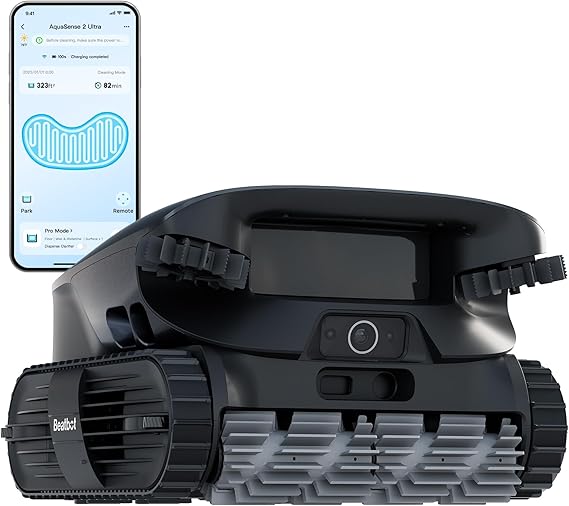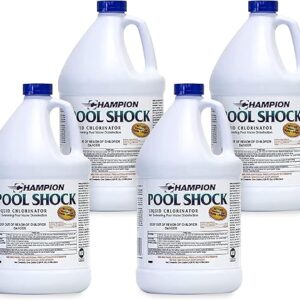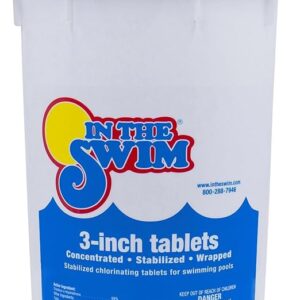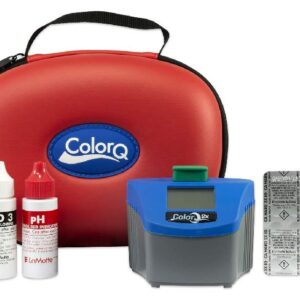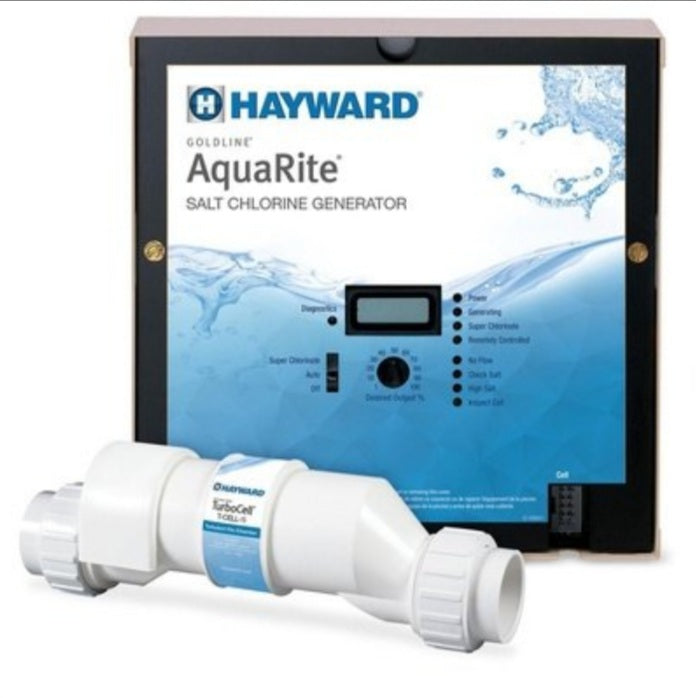How to Correct Low and High Free Chlorine Level in a Saltwater Pool

One advantage of a saltwater swimming pool over a non-saltwater pool is that you don’t need to manually measure and adjust the free chlorine level (FCL) by adding harsh chlorine.
A Saltwater Chlorine Generator (SWCG) produces chlorine and adds the right amount to your water to maintain the recommended FCL.
However, some of the potential issues of a saltwater pool are low or high free chlorine levels and scaling pH levels.
Chlorine demand in a pool depends on several factors, such as water temperature, room temperature, seasons, and pool activity. it’s therefore essential to regulate the amount of chlorine your saltwater generator produces and adds to your pool.
Most Loved Cordless Pool Cleaner: Aiper Scuba S1 Cordless Robotic Pool Vacuum Cleaner: Cleaning Schedule, Smart Navigation, Wall, Floor, & Waterline Cleaning, Suitable for all Pools Up to 1,600 sq.ft
To avoid FCL issues in your pool, make it a routine to measure the free chlorine level in your water at least after a couple of days using a reliable chemical test kit.
You should then adjust the percentage settings in your SWCG to increase or reduce FC level depending on the reading you find.
Chlorine generators will only work with the settings you set. The frequency of testing your FC level should be determined by the factors considered earlier in this post.
For a practical example, if your pool is very busy with many swimmers, your pool will need more chlorine than a less busy pool with few swimmers.
So, make it a routine to adjust the percentage settings in your chlorine generator, low or high, depending on chlorine demand in your pool or spa.
Related Product: CHLORWORKS Salt Cell for Pool – Model CWPC, Compatible with Pentair IntelliChlor IC20, Supports Pools up to 20,000 Gallons
Can I manually add harsh chlorine to my saltwater pool?
Saltwater chlorine generators are designed to produce small amounts of chlorine but consistently maintain the ideal free chlorine level in your water.
You can regulate the amount of chlorine your SWCG produces by adjusting its percentage setting to increase or decrease the FC level in your water.
However, suppose you have cloudy water, algae, or ammonia in your pool. In that case, your chlorine generator cannot produce sufficient chlorine to clear your water or kill algae and ammonia, especially when your SWCG has reached a very high percentage.
In such a case, you must switch off your saltwater generator and manually add harsh chlorine to clear cloudy water, eliminating algae and ammonia. Then, when FCL is stable, you must put SWCG back on.
Related Products: 16000 BTU Heat Pump for Upto 5000 Gallons Above-ground Pools & Spas, Heater and Cooler with WiFi Timer, 120V
Raypak 399,000 BTU Natural Gas Pool Heater – Electric Ignition
How to Fix High and Low Free Chlorine Levels in Saltwater Pools
As indicated earlier, you need to measure and adjust the FC level in your water by adjusting the percentage settings in your saltwater chlorine generator.
The higher the percentage you set for your saltwater generator, the more chlorine it will produce in your water, and the higher the reading of FCL.
You only need to raise FCL when it’s low or reduce it when it’s high, and you should do that in the percentage settings of your chlorine generator after taking the FC reading.
As such, only adjust your SWCG after measuring and knowing the level of FC in your water.
Adjusting the SWCG Percentage Setting
To know the right SWCG percentage setting to produce the ideal level of chlorine for your pool, you have to follow a few steps, and they are:-
1). Determine the right FC level for your pool. FCL in your water goes hand in hand with the Cyanuric acid level.
2). Measure the actual FCL in your water and compare it with the appropriate FCL in your SWCG. Testing FC level should be done in the evening.
3). If the level of FC in your water is low, increase the percentage of your SWCG to produce more chlorine and reduce the percentage if the FCL is high.
4). If the FC level is not balanced within an hour, wait for 48 hours and repeat steps 2 and 3 until your FCL is balanced with the Cyanuric acid level in your water.
Related Article: Saltwater Swimming Pool Maintenance for A Trouble-Free Pool
Causes of High FCL in Saltwater Pools
FCL tends to get high in indoor pools, where the pool is not very busy, and room temperature and water temperature are relatively lower, but the percentage setting in saltwater chlorine generator and pump run-time are set too high, ending up with more chlorine production and high FCL in the end.
To reduce your FC level, reduce the percentage setting of your saltwater generator and pump run-time, which could be high.
To avoid a high FCL problem, measure your FCL frequently and adjust the percentage of your SWCG and pump run-time to regulate the amount of FC in your water.
Related Product: Beatbot AquaSense Cordless Robotic Pool Vacuum Cleaner for Above Ground and Inground Pools Up to 2260 sq. ft
Causes of Low FCL in Saltwater Pools
On the other hand, if your saltwater pool has low chlorine, you are not adjusting your SWCG as required, and the percentage is too low to produce enough chlorine to supplement the chlorine used in your water.
Measure the FC level in your water frequently, especially after heavy pool usage and during hot weather, and adjust FCL by increasing the percentage setting of your SWCG to avoid cloudy water, algae, or ammonia.
If you can’t raise your FCL by adjusting the percentage of your chlorine generator alone, try increasing your pump’s run time, too.
If unable to get your FC level higher and the percentage of SWCG and pump run-time are both very high, you could be having four issues to solve fast, and they are:
1. Excess Cyanuric Acid: Cyanuric acid (a chlorine stabilizer) is potent and consumes FC if it is high in your water, causing high chlorine demand.
Measure and adjust your Cyanuric acid (Cya) level as required. The Ideal level of Cya for a saltwater pool is between 70 – 80ppm and should stay within that; otherwise, you will have a low FCL problem. View this chlorine/Cyanuric acid chart and know the correct Cya levels in a given FCL.
Measure your Cya level and reduce it if it is high by draining and refilling part of your pool water. This is the only practical way to reduce the Cyanuric acid level in your pool, apart from reverse osmosis.
2. Early Stages of Algae: An early sign of algae is low FC levels in a swimming pool. To be sure you are dealing with algae, perform an Overnight Chlorine Loss Test (OCLT).
OCLT is simply adding a specific amount of chlorine in a pool in the evening and taking the FC reading in the morning to establish the amount of FC used at night.
If the FCL drops by more than 1ppm in the morning, you are dealing with young algae, and you need to shock your pool manually after shutting your SWCG because it cannot produce enough chlorine to clear your water.
3. Chloramine or Ammonia: High chloramine levels cause cloudy water with low FCL. If you have ammonia in your pool, chloramine levels will be very high in your water and will require a lot of chlorine to get rid of.
Signs of ammonia in a swimming pool are extremely cloudy water, high combined chlorine levels, low Cyanuric acid levels, low FC levels, and high chlorine demand in your water.
Just like eliminating chloramine and algae, you need to shut down your SWCG and shock your saltwater pool manually using harsh chlorine to get rid of ammonia in your swimming pool.
4. Calcium Buildups in Your Salt Cells: Chlorine is produced in the salt cell of a Chlorine Generator. However, since Calcium is used in chlorine production, Calcium scales always form and accumulate in the salt cell plates, hindering sufficient chlorine production and leading to low free chlorine levels in your pool.
To avoid Calcium buildups in your chlorine generator’s salt cells, you must regularly inspect and clean your salt cell plates when you see white calcium flakes or scales in your pool to avoid low chlorine production.

